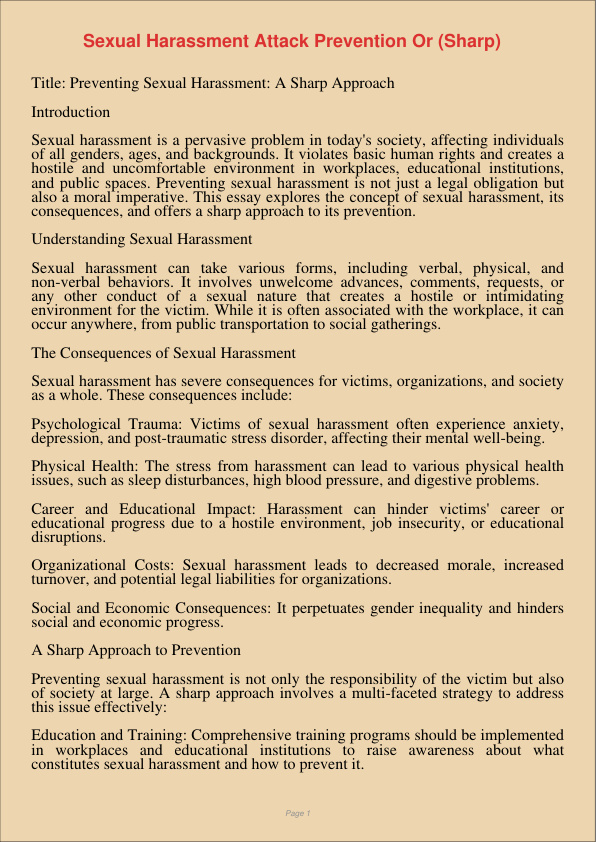Sexual Harassment Attack Prevention Or Sharp
Dec 31, 2023
sexual harassment attack prevention
sharp
Literature
Environmental Studies

Title: Preventing Sexual Harassment: A Sharp Approach
Introduction
Sexual harassment is a pervasive problem in today’s society, affecting individuals of all genders, ages, and backgrounds. It violates basic human rights and creates a hostile and uncomfortable environment in workplaces, educational institutions, and public spaces. Preventing sexual harassment is not just a legal obligation but also a moral imperative. This essay explores the concept of sexual harassment, its consequences, and offers a sharp approach to its prevention.
Understanding Sexual Harassment
Sexual harassment can take various forms, including verbal, physical, and non-verbal behaviors. It involves unwelcome advances, comments, requests, or any other conduct of a sexual nature that creates a hostile or intimidating environment for the victim. While it is often associated with the workplace, it can occur anywhere, from public transportation to social gatherings.
The Consequences of Sexual Harassment
Sexual harassment has severe consequences for victims, organizations, and society as a whole. These consequences include:
Psychological Trauma: Victims of sexual harassment often experience anxiety, depression, and post-traumatic stress disorder, affecting their mental well-being.
Physical Health: The stress from harassment can lead to various physical health issues, such as sleep disturbances, high blood pressure, and digestive problems.
Career and Educational Impact: Harassment can hinder victims’ career or educational progress due to a hostile environment, job insecurity, or educational disruptions.
Organizational Costs: Sexual harassment leads to decreased morale, increased turnover, and potential legal liabilities for organizations.
Social and Economic Consequences: It perpetuates gender inequality and hinders social and economic progress.
A Sharp Approach to Prevention
Preventing sexual harassment is not only the responsibility of the victim but also of society at large. A sharp approach involves a multi-faceted strategy to address this issue effectively:
Education and Training: Comprehensive training programs should be implemented in workplaces and educational institutions to raise awareness about what constitutes sexual harassment and how to prevent it.
Reporting Mechanisms: Organizations should establish safe and anonymous reporting mechanisms, ensuring that victims can come forward without fear of retaliation.
Clear Policies: Implement clear anti-harassment policies and procedures, outlining consequences for harassers and providing support for victims.
Empower Bystanders: Encourage bystanders to intervene when they witness harassment and provide them with the tools to do so effectively.
Legal Frameworks: Strengthen and enforce legal frameworks that hold harassers accountable and provide justice for victims.
Cultural Shift: Promote a culture of respect, equality, and consent in all aspects of society, challenging harmful stereotypes and attitudes.
Support Services: Ensure that victims have access to counseling, legal support, and other services to help them cope with the aftermath of harassment.
Research and Data Collection: Collect data on the prevalence of sexual harassment to identify trends, areas of concern, and measure the impact of prevention efforts.
Conclusion
Sexual harassment is a deeply ingrained issue that requires a sharp approach to prevention. It is not a problem that can be solved by one entity alone; it necessitates collective efforts from individuals, organizations, and governments. By educating, empowering, and holding accountable all members of society, we can work toward a future where sexual harassment is rare and swiftly addressed when it occurs, creating a safer and more inclusive environment for everyone.